|
FAQs about
Marine Mites, including "Red et al. Bugs"
Related FAQs: Crustacean Parasitic Disease, Parasitic Disease 1, Parasitic Disease 2, Parasitic Disease 3, Parasitic Disease 4, Parasitic Disease 5, Parasitic Disease 6, Parasitic Disease 7, Micro-Crustaceans, Amphipods, Copepods, Mysids, Hermit
Crabs, Shrimps,
Cleaner
Shrimps, Banded Coral
Shrimp, Mantis
Shrimp, Anemone
Eating Shrimp, Crustacean Identification, Crustacean Selection, Crustacean Behavior, Crustacean Compatibility, Crustacean Systems, Crustacean Feeding, Crustacean Disease, Crustacean Reproduction,
Related Articles: Isopod
Crustaceans, Crustacean Parasitic Disease,
Shrimp,
Who you callin' a bug?
|
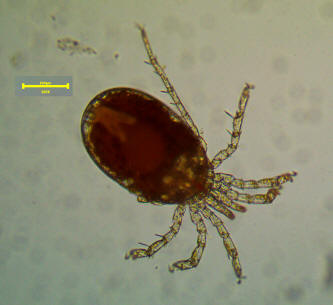
|
|
What could this be? 8/4/16
Hi I found a few of these critters crawling on some Zoanthid frags. You can
not see these with the naked eye. I found them with a jewelers loupe and
then took these photos with my iPhone under a microscope. Hoping they are a
detritivore but I am fearing the worst. Thanks in advance.
Brian
<Appear to be Mites/Acarinans... I wouldn't panic. Bob Fenner>
|
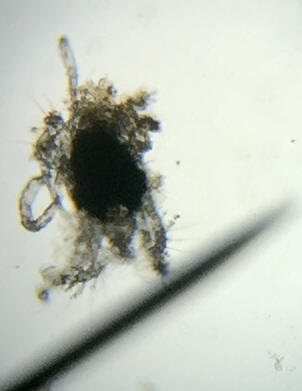
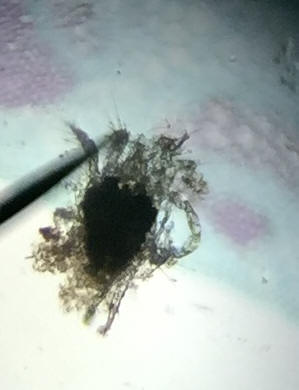
Re: What could this be? 8/5/16
Bob,
Thanks for the quick reply.
In most non-aquarium related cases 'mites' aren't really a good thing! What is
the purpose of these guys in a reef tank? What do they feed on?
<Purpose...? Feeding... could be on a few sources here... My overall direction
I've noted: These Acarinans are likely of no or little concern in a healthy
system. Some get "picked off" by predators...>
I have seen them crawling on all types of coral but I think its because it's
much easier to spot it moving on coral as opposed to rock or frag plugs.
<Mmm; read here:
http://wetwebmedia.com/swmitefaqs.htm
Thanks again,
Brian
<W. BobF>
|
|
RE: Worm ID? (And now for something completely different.)
3/3/14
Well, while I was looking for another example of that worm, I came
across something else.
<Happens>
I've seen this critter in my USB cams a couple times- at first, I
thought it was just another Ostracod, but it doesn't move like a typical
Ostracod.
http://www.youtube.com/watch?v=_CcYyxtfwcg (view full screen,
look in the upper left, you'll see it motoring around a grain of sand.)
<Have seen this, there...>
This time, I saw one while trolling through a sample of sand and was
able to separate the grain of sand it was on. Then I got it onto a
regular slide with a cover slip.
I think I broke off one of his 8 legs. Poor guy. (Or gal.)
http://srv.rowelab.com/fish/microscopy_3_2_14/mite1.jpg --
overhead view
in the dissection scope at its limit, ~75x. Sorry for the blurry focus,
I added a drop of carbonated soda to slow this guy down, but it took a
long time to take effect.
Better view under a compound scope, at 100x magnification
http://srv.rowelab.com/fish/microscopy_3_2_14/mite2.jpg
http://srv.rowelab.com/fish/microscopy_3_2_14/mite2.jpg
As my photo names indicate, I'm guessing some kind of marine mite?
<Likely so>
I love finding new things!!
Thanks,
-Scott
Fort Worth, TX
<Me too; Bob Fenner>
|
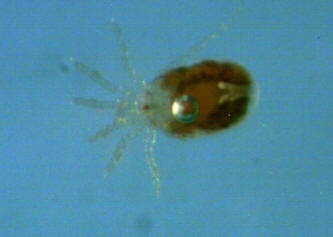
 |
Bug problem... lack of desc., reading 9/16/07
Hey! I read your site all the time but cant seem to find anything that
talks about weird little bugs that seem to be damaging my polyps and
yellow gorgonian. The Gorg is definitely getting eaten and there are
tiny little white bugs all over it. <A photo? Description? Reading
on WWM?> The polyps are just folding down like an umbrella and I can
see some spider looking <Pycnogonids?> bugs bugging them when the
light are out. I will shine a flashlight at them and they scat real
fast... The back of my tank has alot <No such word> of bugs on it
too.. ALL my fish are in a QT due to an Ick outbreak about 5 weeks ago.
I did not notice these bugs then... <Could be the fishes were
keeping their numbers in check> Could majority of these be copepods?
<Possibly, yes> I have always wanted a Mandarinfish! LOL. I just
really don't want to see my corals being damaged. Any help would be
nice! Thank you Jason <Reading Jason... and some well-resolved pix
close-ups... Bob Fenner>
|
Wrasse compatibility <Actually sel. to
eat/control>, red bugs, <and comp. w/> Anthias
9/11/07 Hi Crew, Would you be able to
help with the best choice for a small wrasse that likes to eat
Acropora red bugs? <Um, this is not how one deals with red
bugs.> From reading the FAQs it looks like the Six Line is an
option, but I've seen them be aggressive and I have a trio of
Bartlett's Anthias that I wouldn't want to be harassed.
The tank is a 135G reef with 100+ lbs of live rock. Can you think
of a small, red bug eating wrasse (or other fish/invert) that
would tend to be less territorial than a Six Line? And do you
think I would need more than one bug-eater in this size tank?
<If you have a red bug infestation, you need to treat it with
Interceptor. There's no aquarium fish (known to aquarists)
that will solve this problem. See here:
http://www.ericborneman.com/Tegastes-content/Dorton%20treatment.htm
And maybe here too:
http://www.wetwebmedia.com/acrodisfaqs.htm> Thanks, Tom <De
nada, Sara M.>
Follow up on Interceptor use for Tegastes red bugs
-11/19/07 Sara, The Interceptor medication seems to have
worked very well for the red bug infestation, as no bugs were
visible on the Acros at the end of the treatment period. I
followed the instructions at
http://www.ericborneman.com/Tegastes-content/Dorton%20treatment.htm
except that I treated the tank only once, not the three times as
recommended. It's been about 5 weeks since the treatment and
still no red bugs visible. <Excellent! Well done.> There
seems to have been no ill effects on the fish, corals, or bio
filtration, and the pod population in the Fuge is alive and well.
I didn't have any shrimp or hermits in the system, so that
wasn't a concern. <Good to hear.> One tablet can treat
380 gallons, so I used about 1/3 of a tablet since I estimated
125 gallons actual water capacity in my tank/sump system. I
didn't have access to a scale to weigh the medication, so I
simply crushed and chopped one tablet into powder and visibly
split it into thirds using a razor blade and a mirror (good thing
no one saw me doing that, they may have gotten the wrong idea).
<lol> I then mixed the powder with 2-3 cups of tank water
in a plastic jar before pouring it into the sump. Thanks again
for that tip. At least two of the Acro colonies that were
affected have now developed several new growth buds, and the
polyps in all the Acros are more active. <fabulous> If only
there were such effective and targeted treatments available for
some of the other problems that reef keepers need to deal with
now and then. <Hopefully in time there will be. Thank you so
much for the update/testimony.> Tom <Best, Sara M.
|
Re: Wrasse compatibility, red bugs, Anthias
9/12/07 Hi Sara, Thank you, I do like getting more than one opinion
because I did see suggestions in the WWM FAQs to "consider
stocking some small wrasses", or to try a "Red Sea
Pseudochromid, small wrasse" when I searched WWM for info on red
bugs. <Yes, one of the cool things about WWM is that it stores
queries spanning several years (and from many different people). The
use of Interceptor for red bugs is still a very new idea. Dorton
developed his protocol in 2004 (just 3 years ago). You must have read
some of the responses of Eric R. who is not so warm to the idea of
using of Interceptor or any such deadly (and largely under-studied)
medication on whole systems. See here for his take on it:
http://www.wetwebmedia.com/swmitefaqs.htm. Generally, I certainly agree
with him. I do think aquarists often jump to extreme treatments too
quickly. I even did it myself in my first response to your query. I
jumped to the conclusion that you must have a pervasive and devastating
infestation of the dreaded Tegastes acroporanus. But I did you a
disservice in not explaining the very real possibility that these bugs
you have might not be T. acroporanus. Regarding fish, many of them eat
little bugs. And some fish are not so picky and could eat red bugs
along with everything else they might be hunting. And so in that way,
they might serve as a bit of a preventive measure. However, anyone
who's ever had a really bad red bug infestation will tell you that
the fish just don't eat them fast enough even when they do eat
them.> Also saw replies that made me think these critters may not be
that much of a problem, potentially being more commensal than
parasitic. <Please accept my apologies for not thinking to mention
this myself. It is a possibility. However, finding them on dying corals
does make them a bit more suspect. Still, they could just be
scavengers.> What has your experience been with red bugs...big
problem, or not so big? <I've personally never had Tegastes
acroporanus. However, I have been scared by many different hardly
visible "bugs" I've seen crawling on my coral. I once had
some that looked just like red bugs except that they were black. There
are just soooo many different types of "bugs" that can get
into our aquariums. See here:
http://reefkeeping.com/issues/2002-10/rs/index.php Certainly there are
people who can tell you all about how red bugs destroyed whole colonies
of their corals. Others may tell you that they've seen them in
their tank and they never became a problem. Personally, I wonder if the
people who claim to have them but that the bugs never became a problem
truly had red bugs (i.e. Tegastes acroporanus) and not some other kind
of less aggressive copepod (like maybe my "black bugs" which
disappeared as mysteriously and they came).> The red bug infestation
in my tank seems to be limited to a few of the weaker-looking Acro
frags/small colonies, at least so far. I'm not sure if the red bugs
are causing these Acros to be slower growing and have poor polyp
extension, or if it's the other way around. <very astute and
good question to be thinking about> I do pay close attention to the
water conditions and husbandry, and have several other Acros and other
SPS (Stylophora, Montipora, Seriatopora) that show good color, polyps,
and growth. I've just figured that some specimens don't do as
well in aquariums as others do, or at least in mine. <This is
possible. Or, you could have the dreaded red bugs. Hmm, this is where a
picture could help.> Also, thank you for the Borneman link. If I do
go with the Interceptor treatment, could you help clarify a couple of
things for me? Since several of these Acros are growing on very large
pieces of live rock that are integral to the support structure,
removing them for treatment would be difficult...would you consider
treating your whole tank if you were in my situation? <Actually, the
protocol described on that site (developed by Dustin Dorton) calls for
both quarantining of the corals AND treatment of the whole tank.
However, as mentioned, the use of Interceptor is still a new idea. If
you can confirm that you actually do have the predatory red bugs (and
not just some kind of scavenging copepod), you could experiment with
just treating the whole tank with a low dose (without removing the
corals). However, you should definitely try to make sure you actually
do have Tegastes acroporanus before trying this.> I don't keep
any crabs or shrimp. I know the pods would suffer, but those could be
re-seeded. Also, is Interceptor considered safe for Crocea clams? From
what I've read, it appears to be safe but would like to get your
view. <I don't see any reason to expect Interceptor to hurt
clams. Clams are quite dissimilar from crustaceans biologically. But
again [the disclaimer] we just don't know a lot about this
medication when using it on an entire 'ecosystem.' > Thanks,
Tom <Thank you for the thought provoking query, Sara M.>
<<Well done Sara. RMF>>
Re: Wrasse compatibility, red bugs, Anthias Sara, thank you
very much for your time and advice. I'll see if I can get my hands
on a better camera, but here's the best picture I could get with
the camera I have. The color of this 1.5" Acro frag is normally
more yellow, but is lately a lighter shade. You can see what looks like
small reddish "bugs" on it. <Ugh, yeah, it does look like
these could be the bad guys. Have you tried to blow them off with a
powerhead? ...because the bad ones tend to cling on hard to the coral
and are difficult to remove. If the damage seems slow and confined to a
few corals, you can still wait and see what happens with them. But if
they start jumping to other Acropora colonies, I'd seriously start
thinking about the Interceptor. You could always start off with a very
low dose...> Tom <Best, Sara M.>
|
Blue Zoa BUGS!!! 8/20/07 Hey crew, Thanks in advance
for all the info already given and provided to us all. Your
site/info has been a great resource for me and am sure for
others. I am wondering if you could ID these bugs I recently
found on my blue Zoas. These bugs seem to make the polyps close
randomly in groups. Getting a great picture if these bugs has
been tough without sucking or attempting to suck them out with a
baster. Less than a millimeter in length, clear, has 2 antennae
coming from its head, has multiple legs cant tell home many
because its so small. The Zoas and the rock are teaming with
these bugs. I have attached a picture to help, don't know how
much help it might be. I can always suck one out with a baster in
order to get a better picture if needed. Thanks for all the help
for giving me a good understanding of what is needed in order to
take care of and maintain a marine Aquarium. <Mmm... well...
there are a few approaches to control here... with the usual
"range of desirability"... biological, physical,
chemical last... You can/could interpolate these by a cursory
read here: http://www.wetwebmedia.com/swmitefaqs.htm Do you have
another "isolation" tank that you might use to
eradicate the bulk of these pests? Bob Fenner.
Re: Blue Zoa BUGS!!! 8/20/07 After
reading am not to concerned about these bugs just the number of
them and the Zoas not opening or only opening for a shirt time.
Well, I have am still working on the tanks filters, its an all
glass not drilled tank and invested in an overflow with
Aqualifter pump, I had plans to have a isolation tank plumbed
inline back to sump for an isolation tank. At the moment it is
not set up. I do have a 10gal tank sitting around. Thank you.
<I do think you're wise to ignore these for now. Bob
Fenner>
Re: Blue Zoa BUGS!!! 8/23/07 Thanks
for the quick reply once again. Figured you were tired of hearing
from me, the unwise. Well I see eight legs very hard to determine
but definitely looks like there are 8 legs. I noticed when I
first put the Zoas in my main tank my Pseudochromis fridmani
(spelling?) was picking at the rock, not to sure it was eating
anything or not. If I were to get a 6line or a line wrasse
I'll run into compatibility issues correct? <Mmm... in a
tank this size, I give you good odds of not having real trouble
here> 75gal 110lbs live rock. I fear with me having the
Pseudochromis fridmani (was my first fish), already has his
territory staked out pretty much all the rock on the bottom half)
that he will go after a lined wrasse if introduced into my
system. I notice with some research to use caution when putting
these 2 species together, as long as they don't resemble each
other, or need to be introduced at the same time? <The Lined
Wrasses are pretty sharp, and fast!> Combination of both? Or
just plain luck or am just stupid for even trying to put these
species together in the same tank. I would just as easily return
the Pseudochromis fridmani (AND THE TWO 3 STRIPED DAMSELS!!!!)
but I can not. Girlfriend picked them out for our first fish so
kinda stuck with them till he dies (hmm.... gives me an idea,
j/k). Thank you Bob you have been of great help. -Jay <Welcome
Jay. BobF>
Re: Blue Zoa BUGS!!! 8/24/07
Thank you for all the help you have been, I think for now I will
tolerate the spiders, but if continues to be a "major"
problem which already seems to have lessoned I will be adding a
wrasse. Thanks again Bob for all the help. -Jay
<Welcome my friend. BobF>
|
|
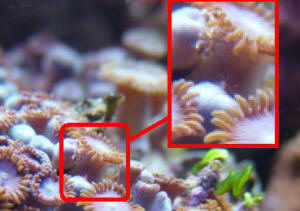
|
Interceptor Treatment For Red Bugs - 11/13/06 I've
searched the Internet and see that people recommend a 25% water change
and carbon treatment after 6 hours of treatment with Interceptor.
<<Personally, I would never have used this product or anything
similar in my system>> Other than the effects on crustaceans
(hermits, pods, etc.), I don't see a reason to do anything so soon
after treatment. Why not change the water and add carbon
after 12 or 24 hours to ensure maximum effectiveness, particularly
since many people report RB recurrence after single treatments?
<<Why indeed...you have already damaged your system at this
point>> I can't even find anecdotal evidence that supports
the assertion that short treatments are the way to go. <<I'm
convinced that indiscriminate chemical biocides are "not" the
way to go. Regards, EricR>>
Re: Interceptor Treatment For Red Bugs - 11/14/06
Thanks for the quick reply. <<Quite welcome>> I totally
agree with your sentiment regarding indiscriminate treatments, but
having found no other high-probability control methods for red bug,
I'm not sure there's an alternative. <<Hmm, in my mind,
the alternative is to not use the treatment. I'll admit
my stand is "not popular" and that many, many hobbyists have
used the Interceptor product...but to what detriment (long or short
term) to their systems. Just because they don't see
anything immediately wrong doesn't mean they haven't disturbed
the "balance">> They've definitely affected polyp
extension on several of my Acros, and no sane person will trade frags
with me as long as I have them. <<To be honest, I think red bugs
(like flatworms) are an overrated pest. Unfortunately you
are experiencing the shortsightedness of most hobbyists re these
critters. Any feared infestation could be avoided by
QT/treatment of the individual frags before introduction to the display
system...and any hobbyists not doing this as a matter of routine is
only fooling themselves anyway if they think they will never have
"problems" at some point just because they think they are
dealing with "clean" systems>> Many of the
Interceptor-alternative recommendations I've found are unsupported
by proof (e.g., Why don't you try pipefish, six-line wrasses,
Lugol's, voodoo?"). <<Indeed...biological predators for
"any" issue (Aiptasia, flatworms, etc.) are at best
hit-and-miss>> Removing affected colonies doesn't remove all
of the RB from the tank. <<Agreed>> What would you
recommend as a control method? <<Mmm...patience, optimum water
quality, adequate feeding, vitamin supplements...you'll likely find
the "problem" will turn out to be "not so much" of
a problem...though you'll still have trouble trading with your
short-sighted hobby friends. I'll be honest with
you, I have red bugs in my system and I don't give them a second
thought. I think many times we as aquarist try to find
something on which to blame our own shortcomings (e.g. - water
quality/maintenance/husbandry/species
incompatibility). I'm not saying this is the case with
you, but those that see my tank (unless they know already) would never
suspect I have red bugs. But like you, most will not trade
with me once they are told...so be it <grin>. Regards,
Eric Russell>>
Acro Red Bugs 7/23/06 Hi
there!!! I just purchased some sps frags. <Hopefully they
are in quarantine...> I did some research about sps pests and came
upon Acro red bugs. When I went to look at the sps frags, a
couple of the frags had these tiny bugs on them. There seem
to be very little of these bugs on the sps. I've spotted
like only 3-5 running around the sps. The frags seem to be
doing fine with normal polyp extension. My question is, how
dangerous are these bugs to the sps? <Mmm, generally "not
very"> Do these bugs multiply as time goes on?
<Can> Should I be worry? <Will worrying change the future?>
As of right now, the sps seems fine so am not concerned about
it. But the thought of these bugs being there stays in my
head and worries from time to time. <Please take a read here:
http://www.google.com/custom?domains=www.WetWebMedia.com&q=Acro+Red+Bugs&sa=Search&sitesearch=www.WetWebMedia.com&client=pub-4522959445250520&forid=1&ie=ISO-8859-1&oe=ISO-8859-1&cof=GALT%3A%23008000%3BGL%3A1%3BDIV%3A%23336699%3BVLC%3A663399%3BAH%3Acenter%3BBGC%3A99C9FF%3BLBGC%3A336699%3BALC%3A0000FF%3BLC%3A0000FF%3BT%3A000000%3BGFNT%3A0000FF%3BGIMP%3A0000FF%3BFORID%3A1%3B&hl=en
The cached views. Bob Fenner>
Red Acro Mites 2/10/06 Hey Crew, 2 of my
Acros have tiny red bugs on them. the polyps on the
coral are in because they are probably stressed out. I
have a fridmani, but he isn't interested. he
prefers spaghetti and meatballs!! I am concerned. I did a
Google on wet web media and didn't find any real
solutions. please advise... best regards, Jenna <Read:
http://www.wetwebmedia.com/acrodisfaqs.htm and the linked
files above. Bob Fenner
Red Acro Mites II - 02/11/06 Hey Bob, thanks for your
help...... <<EricR here this morning...>> Well, I looked
through the link you sent, and found that Interceptor will kill bugs,
but all my crabs as well!! <<Indeed, as well as other beneficial
life! (amphipods, Mysids, etc....maybe even beneficial
protozoa...)>> No good right? <<Not in my opinion,
no.>> I love my critters... <<And your tank loves them
too.>> I also did a Google search, but no info really.
<<Agreed>> I assume it is not really known what to do
right? <<As I am aware, there aren't any
"scientific" studies on these critters and their impact in
aquariums/captive systems.>> All my Acros are infected now,
and they are stressed out. Color is fading, and polyps are
closed. They will probably die, if I don't fix this...
<<Jenna...I have red bugs (Tegastes) in my reef tank for more
than a year now, more likely more than two. I have not lost
any corals due to them, and color/growth/vigor has not been affected by
them...in my opinion. I have not and will not
"nuke" my tank to get rid of them and quite honestly,
don't give them a second thought (an attitude that admittedly, has
drawn scorn and caused me to be shunned by the "fraggers" in
my local reef club...but I digress...). My point is; and
I'm not saying this is the case in your situation, I think many
aquarists are quick to blame their own mistakes in choosing proper
tank-mates or inadequacies in water quality/lighting/flow/feeding on
the Tegastes. Just my humble opinion...no "proof"
either way at the moment. But for your own peace of mind, if
the corals in question can be removed from the display tank you do have
a couple options you can try. You could place the affected
corals in a bucket of tank water with a powerhead and heater and treat
per instructions with the Interceptor...or...you could simply give the
corals a 15 second bath in temperature and pH adjusted RO
water...though the second option is harder on the coral. And
do be aware, neither of these options guarantees the corals won't
become "reinfected" once reintroduced to the
display. I don't know that all this helps you much but
as you've discovered for yourself, aside from anecdotal evidence or
knee-jerk reaction, there's not much to go
with. Regards, EricR>>
|
|

